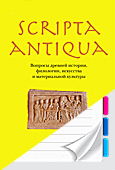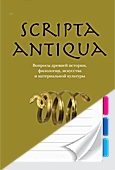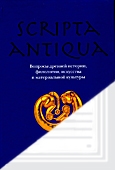Доцент кафедры истории древнего мира исторического факультета МГУ имени М.В. Ломоносова.
Ист.: Scripta antique. Вопросы древней истории, филологии, искусства и материальной культуры: альманах. Том IX. 2021. Москва: Собрание, 2021.

Scripta antiqua. Вопросы древней истории, филологии, искусства и материальной культуры. Том IX. 2021. Москва: Собрание, 2021. С. 11-47.
Роль старых людей и представления о старости в хеттском обществе еще не становились предметом подробного рассмотрения в научной литературе. Сложность изучения этой проблематики связана с недостаточным объемом информации в дошедших до нас источниках. Тексты земельных пожалований позволяют предположить, что старые люди составляли примерно 9% населения Хеттского царства. Женщины преобладали среди этой группы. Старые люди пользовались почетом и уважением младших поколений. Известны случаи прекращения военных действий после обращения к хеттскому царю делегаций старых людей, представлявших сторону противника. забота о старых людях, как правило, была возложена на их ближайших родственников и семьи. Системы государственного обеспечения и поддержки старости не существовало. Долголетие предстает как безусловная ценность в хеттских текстах. Вместе с тем в текстах присутствует и пессимистический взгляд, согласно которому старый возраст неотделим от страданий.
B.E.Alexandrov (Moscow). OLD AGE AND OLD PEOPLE IN THE HITTITE TEXTS
The role of elderly persons in the Hittite society as well as the Hittite concepts of old age have not yet received an exhaustive treatment in the scholarly literature. The difficulty of studying this subject is related to the insufficient information in the extant sources. The land donations texts allow a conclusion that the old persons represented ca. 9% of the Hittite population. Women were in majority among this group. The old persons were honored and enjoyed the respect of the younger generations. Historical texts describe cases in which the military operations were stopped after the delegations of elderly representing the enemies of the Hittites had addressed to the Hittite king. The care of elderly was a duty of their families and relatives. No state system of support of the old age existed. Longevity appears as a fundamental human value in the Hittite texts. However, a pessimistic view was quite common according to which the old age is inseparable from suffering.

Scripta antique. Вопросы древней истории, филологии, искусства и материальной культуры. Том V. 2016. Москва: Собрание, 2016. С. 111–131.
В результате публикации текстов из Табету (совр. Телль-Табан) и Дур-Ашшур-кетти-лешера (совр. Телль-Бдери) стало известно о существовании царской династии, правившей страной Мари на Среднем Хабуре во второй половине II тыс. до н.э. Последние исследования Д.Шибаты показали, что истоки династии восходят к концу XIV в. до н.э., а ее первые представители носили хурритские имена. В статье предпринимается попытка вписать новые данные о царях Мари в более широкий контекст политической истории Верхней Месопотамии.
B.E.Alexandrov (Moscow). THE ROYAL DYNASTY OF MARI IN THE CONTEXT OF THE
POLITICAL HISTORY OF THE UPPER MESOPOTAMIA OF THE XIII CENTURY B.C.
The newly published texts from Ṭābetu (modern Tell Ṭāban) and Dūr-Aššur-kettī-lēšer (Tell Bdēri) on the Middle Habur river brought evidence on the dynasty of local rulers whose country bore the name of Māri. As was convincingly demonstrated by D.Shibata, the origins of the dynasty went back to the end of the XIVth century BCE. Another important fact is that its first rulers had Hurrian names. The present article seeks to examine these new data in a more wide perspective of the political developments in the XIIIth century BCE Upper Mesopotamia. One of the intriguing events of the history of that period was usurpation of the throne of Hanigalbat by a certain Shubrian (i.e. Hurrian) king who is mentioned in Akkadian letter KBo 1.20 found in the Hittite capital Hattusa/Boğazköy. As was already argued, this ruler cannot be identified with any of the kings of Hanigalbat known from other sources, i.e. with Shattuara I, his son Wasashatta and Shattuara II. The same is true for the unnamed king of Hanigalbat who sent his Hittite overlord a self-justification letter known as IBoT 1.34: the information which the author provides of himself does not match with the data on Shattuara I, Wasashatta and Shattuara II. Meanwhile, the contents of KBo 1.20 and IBoT 1.34 are mutually compatible and can be seen as presentation of one and the same situation viewed through the eyes of its different participants. This leads to an assumption that the main protagonists of two texts, i.e. Shubrian king and unnamed king of Hanigalbat, could be one and the same person not identical with any of the three other rulers of Hanigalbat. The political activity of this person could have fallen within the last years of Adad-nērārī I and the very beginning of Shalmaneser I’s rule. Of course, the lack of relevant sources doesn’t permit to establish the identity of this mysterious ruler. One is only left with highly hypothetical assumptions one of which was to equate the Shubrian king with […]-Sharruma, a king / or a man of Shubri who sent gifts to Assur according to the administrative text Assur.2001.D-2279. With the new data on the history of Middle Assyrian Māri on Habur it becomes tempting to take into consideration her early kings as well, especially Zumiya and Adad-bēl-gabbe I. The reasons which allow comparison of the said Māri rulers with the king of Hanigalbat of KBo 1.20 & IBoT 1.34 are geographical proximity of two lands, Hurrian origin and some sort of cooperation with Assyria on the both sides. The chronological context of KBo 1.20 & IBoT 1.34 fits the approximate dates of Zumiya and especially that of Adad-bēl-gabbe I. Needless to say, every scenario which means Māri kings’ active engagement in the international politics outside their home region will remain highly speculative: the Habur archives still lack explicit information in this regard. We must wait for new material either to prove, or to dismiss once and for all a possibility of equating the enigmatic king of Hanigalbat with some of the Māri dynasts.

Scripta antique. Вопросы древней истории, филологии, искусства и материальной культуры. Том II. 2012. Москва: Собрание, 2012. С. 185–208.